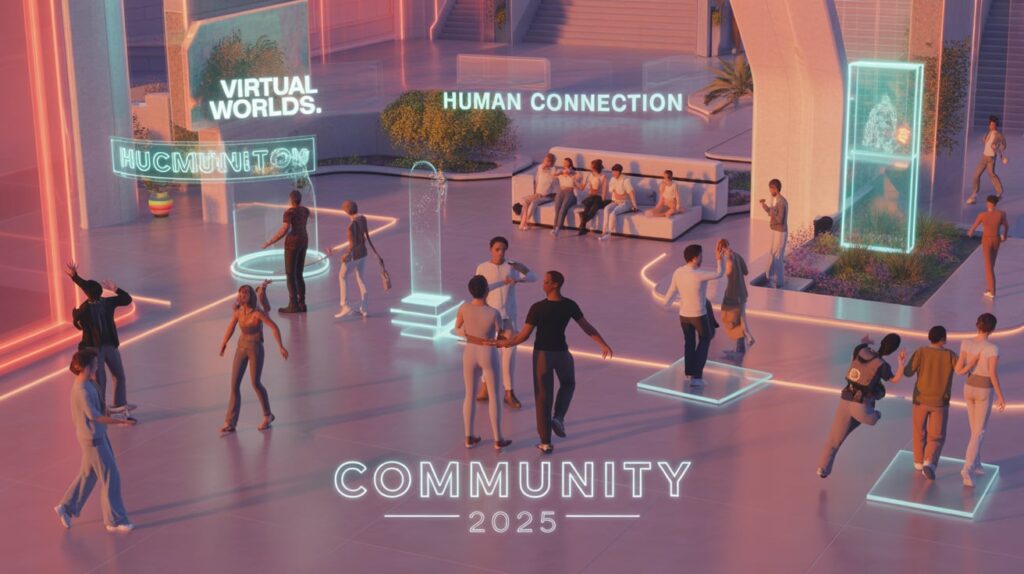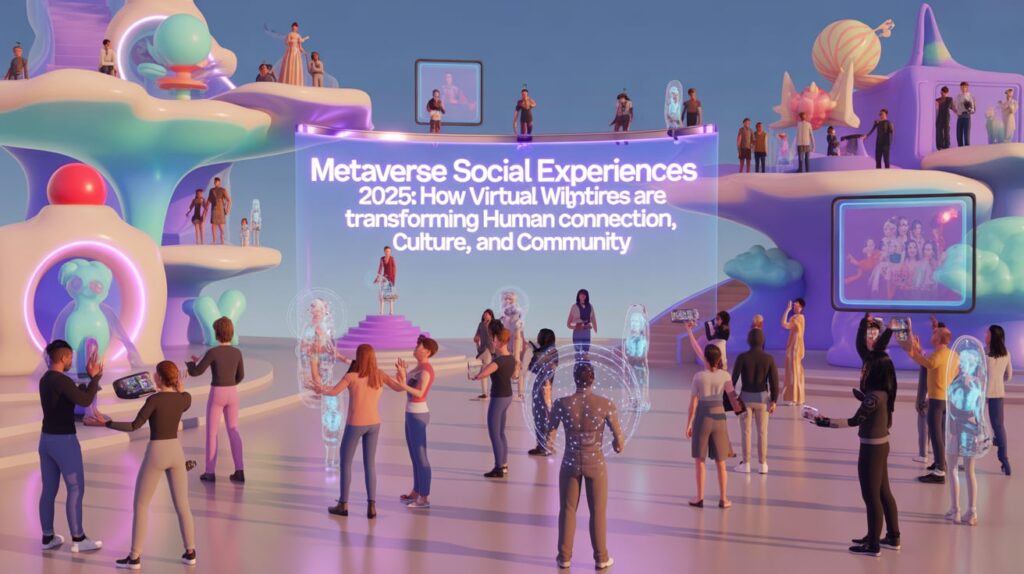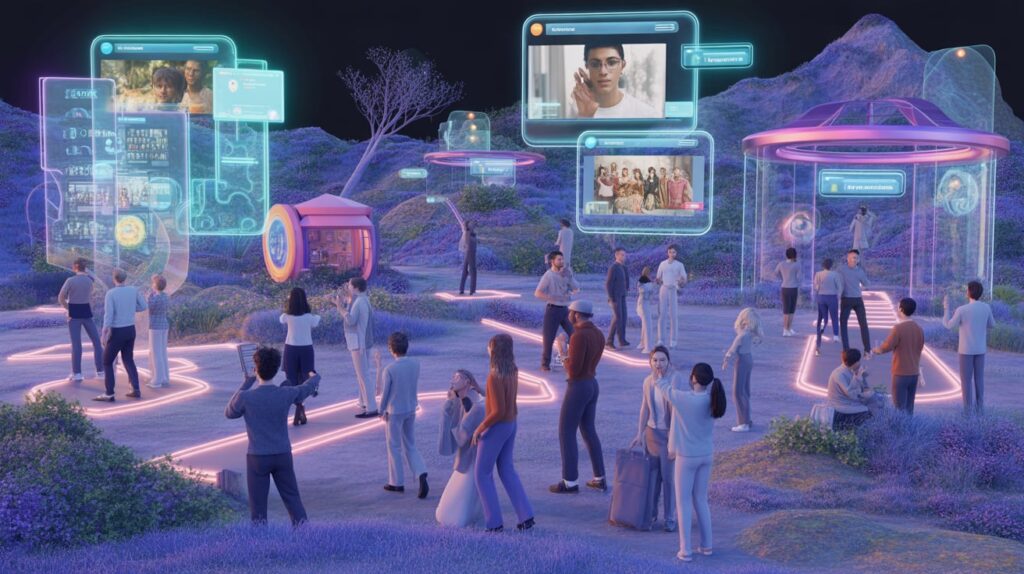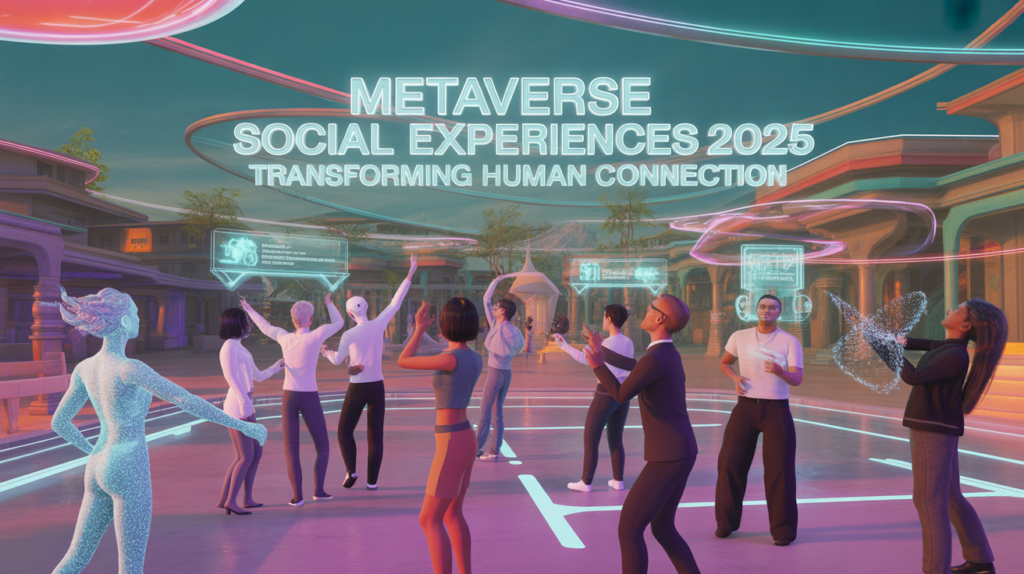Metaverse Social Experiences 2025: How Virtual Worlds Are Transforming Human Connection, Culture, and Community

Introduction: The Dawn of a New Social Reality
Imagine walking into a virtual concert where your favorite band performs in real-time, surrounded by fans from across the planet — everyone cheering, dancing, and talking, not through screens, but inside a living 3D world.
This isn’t science fiction anymore — this is the Metaverse social experience of 2025.
Once dismissed as a gaming fad, the Metaverse has evolved into a rich social universe — a space where people meet, build relationships, attend events, collaborate for work, and express their creativity without physical limits. It’s where social media finally grows up — from flat timelines to fully immersive, emotional experiences.
Today, we’re exploring how social experiences in the Metaverse are reshaping the way we interact, celebrate, love, and belong.
Chapter 1: The Evolution of Human Connection
1.1 From Text to Touch: How Social Interaction Evolved
Our digital journey began with text chats, then moved to photo sharing, video calls, and live streams. But no matter how advanced, those experiences lacked the most human ingredient — presence.
The Metaverse finally solves that.
Here, people don’t just see each other — they feel present together. Whether through virtual reality headsets, augmented spaces, or 3D avatars, the Metaverse bridges distance in ways traditional social networks never could.
When you meet someone in VRChat, Horizon Worlds, or Decentraland, you’re not just sending messages — you’re sharing a moment.
1.2 From Social Media to Social Worlds
The difference is simple:
-
Social media connects content.
-
The Metaverse connects people.
Instead of scrolling endlessly through posts, users enter digital environments — virtual coffee shops, galleries, or game worlds — where conversation happens naturally.
By 2025, the concept of “logging on” has transformed into “stepping in.”
Chapter 2: What Are Metaverse Social Experiences?
2.1 Beyond the Screen

Metaverse social experiences refer to immersive, shared digital events that replicate — and often enhance — real-life interaction. These can be:
-
Virtual concerts and parties
-
3D coworking and study spaces
-
Digital dating meetups
-
NFT art exhibitions
-
Metaverse weddings or religious gatherings
-
Community hangouts, games, and therapy groups
In short, every human experience — friendship, love, learning, creativity — now has a virtual twin.
2.2 Where It’s Happening
Some of the most active Metaverse social platforms today include:
-
Meta Horizon Worlds – A thriving virtual city powered by Meta, filled with concerts, meetups, and public events.
-
Roblox – No longer just for kids; now a hub for digital music festivals and social commerce.
-
VRChat – The most expressive social platform where avatars come alive through voice, gesture, and motion.
-
Decentraland – A blockchain-based world where users own land, host events, and run social businesses.
-
Sandbox – Merging creativity, gaming, and community building into one massive virtual playground.
Each world offers a different flavor of connection — but all share the same mission: bringing humans together in digital form.
Chapter 3: Why People Love Metaverse Social Experiences
3.1 Presence Over Pixels
There’s something magical about standing beside someone — even virtually.
Body language, laughter, shared attention — all the subtle signals that make communication human — are now part of online life.
A 2025 Stanford study found that participants felt 78% more emotionally connected during VR social interactions compared to video calls.
The Metaverse restores the sense of togetherness the internet once took away.
3.2 A Place Without Borders
In the Metaverse, geography disappears.
A teacher in London can host a class for students in Nairobi, São Paulo, and Delhi. A jazz band from New Orleans can perform for fans in Seoul. People separated by oceans share one space — instantly.
This global inclusivity makes the Metaverse the most diverse social ecosystem ever created.
3.3 Freedom of Expression
Avatars are digital reflections of self.
Some choose to look like their real selves; others express identities they’ve always dreamed of. You can wear wings, glow in neon, or dance as a dragon.
The Metaverse allows authenticity through creativity, empowering people to be who they truly are — or who they wish to be.
Chapter 4: The Psychology of Virtual Connection
4.1 Real Feelings in Virtual Worlds
When people laugh, gesture, or make eye contact in VR, their brains process those cues as real social bonding. That’s why friendships formed in the Metaverse often feel as deep as physical ones.
Couples who met in VRChat are now getting married in real life.
Therapists host mental health sessions in serene virtual spaces.
And long-distance families celebrate birthdays together in shared 3D homes.
These aren’t simulations — they’re extensions of reality.
4.2 Digital Empathy and Social Healing
The Metaverse is becoming a safe haven for those isolated by geography, health, or disability.
Communities for anxiety support, chronic illness, and neurodiversity thrive in virtual worlds where stigma disappears.
For many, virtual social experiences aren’t escapism — they’re connection made accessible.

Chapter 5: The Social Events Redefining Entertainment
5.1 Virtual Concerts and Festivals
The Metaverse has reinvented entertainment.
Global music icons now perform in virtual venues where millions attend without physical limits.
-
Travis Scott’s Fortnite concert drew 45 million viewers.
-
Ariana Grande’s Rift Tour became a multi-sensory spectacle.
-
BTS and The Weeknd now perform interactive “metaverse residencies,” where fans can join in, sing, and even co-create visuals.
The future of live performance is participatory — not passive.
5.2 Sports in the Metaverse
NBA, FIFA, and UFC have all launched virtual arenas, letting fans attend matches, interact with players’ avatars, and buy digital collectibles in real-time.
Some events even offer “dual-viewing”: VR seats synchronized with real-world stadium cameras — a front-row experience from your couch.
5.3 The Rise of Virtual Tourism
Why fly to Paris when you can walk its streets in ultra-realistic 3D with friends?
Metaverse tourism blends gaming, culture, and education. Museums like The Louvre VR and Smithsonian Metaverse Hall allow millions to explore artifacts interactively.
It’s not replacing travel — it’s redefining discovery.
Chapter 6: Work, Education & Collaboration as Social Experience
6.1 Offices Without Walls
The Metaverse workplace is social by design.
Employees meet as avatars in digital offices, brainstorm with virtual whiteboards, and attend “watercooler” meetups.
Companies like Microsoft (Mesh) and Accenture’s Nth Floor are pioneering VR workplaces that blend productivity with camaraderie.
6.2 Learning in Immersive Worlds
Education is now interactive.
Students no longer watch lectures — they experience them.
Imagine studying ancient Egypt by walking through pyramids or learning biology inside a beating 3D heart.
Universities like Harvard, MIT, and Stanford run Metaverse classrooms, where learning becomes a shared adventure.

Chapter 7: The Social Economy — When Friendship Meets Finance
7.1 NFTs as Social Identity
NFTs (Non-Fungible Tokens) now represent more than art — they’re social status symbols, access keys, and digital identities. Owning a rare NFT can grant access to exclusive Metaverse clubs, events, or friend circles.
7.2 Virtual Businesses & Influencers
Creators now earn from hosting virtual parties, designing digital clothing, or building 3D hangouts. “Metaverse Influencers” have fanbases larger than YouTubers, shaping trends across worlds.
A single digital concert outfit can sell for thousands in cryptocurrency — proving that social expression has become valuable.
Chapter 8: Challenges in Metaverse Socialization
8.1 Privacy and Data Ownership
Where identity thrives, so do privacy risks. Users are now demanding decentralized identity (DID) solutions that protect their data and let them control what they share.
8.2 Toxicity and Digital Ethics
Moderation in virtual spaces is complex. Developers are building AI-driven tools to detect harassment, but digital etiquette still needs to evolve.
8.3 Accessibility
Not everyone can afford VR gear — yet. However, with cheaper AR glasses, mobile access, and lightweight web-based Metaverse apps, inclusivity is improving fast.
Chapter 9: The Future of Metaverse Social Experiences
9.1 Sensory Immersion
By 2030, haptic suits and neural feedback will let users feel touch, temperature, and motion — turning virtual hugs, handshakes, or dances into real sensations.
9.2 Cross-Platform “Metaverse Citizenship”
Digital passports, avatars, and wallets will let users carry their identity seamlessly across all platforms — forming a unified social universe.
9.3 AI Companionship and Digital Friends
AI-driven avatars are evolving into companions that can hold conversations, remember experiences, and even provide emotional support.
Social interaction is becoming personalized, intelligent, and emotionally aware.
Chapter 10: Why This Matters — The Human Side of the Metaverse
At its heart, the Metaverse isn’t about technology — it’s about people.
It’s a world where creativity flourishes, loneliness fades, and cultures blend. Where introverts become leaders, and communities thrive without limits.
The future of social interaction won’t be measured in clicks or likes — but in shared presence, emotion, and connection.
Conclusion: The World Beyond the Screen
The Metaverse social experience represents humanity’s next big leap — from connecting through data to connecting through dimension.
We’re entering an age where our digital lives don’t just complement reality — they enrich it.
As we stand on this threshold between worlds, one truth shines clear:
The Metaverse isn’t an escape from reality — it’s the expansion of it.